Porcelain Insulator News
by Jack H. Tod, NIA #13
Reprinted from "INSULATORS - Crown Jewels of the Wire", June 1980, page 26
Dear Jack:
...and a friend has a white porcelain signal
which was found in Canada, and it has an incuse "HESCHO / H" marking
on the skirt. Am just curious as to the meaning of the marking.
Bernard L. Warren, NIA #1828
Anchorage, Alaska

- - - - - - - - -
Dear Bernard:
The HESCHO insulators are of
Japanese manufacture and are found in use by a number of Canadian utilities. [See Lovely letter in April issue, plus the one below.]
Jack
Dear Jack:
Since my
last letter, I have acquired three more of the HESCHO insulators -- one brown,
one powder blue, one darker blue. These all have an H under the name, whereas
the other one had an M under the name. I would assume these single letters would
be or could be mold marks, but who knows?
As you suggested, I have done some
checking for some Hescho literature with the power company here but so far have
just flattened my nose from running into the proverbial brick wall! I'll keep
trying though, and someday I might run into someone who knows where to look.
Bill Lovely, NIA #390
Regina, Sask., Canada
- - - - - - - - -
Dear Bill:
Thanks for additional
info on Hescho's. I guess there isn't any mystery remaining as to these being
Japanese manufacture and being used by at least Canadian utilities, but it would
be recordable as a victory if someday we could get the catalog or data sheets
for them from a utility. We'd natch then know the manufacturer, their complete
line, etc.
If inquiring at a utility, don't ask guys "out
back", but ask "up front" -- either (1) the purchasing agent who
buys them or (2) the office of distribution or transmission line engineers who
specified which ones to buy. Either or both should have the catalogs in their
files. If a large utility, the catalog could be in their library -- usually with
all the insulator catalogs on one shelf or in one file drawer.
Single code
letters are used on insulators for various reasons, most generally in earlier
years as code for trimmer operator, for quality control purposes. But such
letters integral with the regular marking stamps, especially in past 35 years,
usually designate one specific version of one given catalog item. This is
connected with subtle variations in groove width(s) and exact shape of the
crown. Some versions of a given catalog style have very minor variations to accommodate
use of preformed tie wires of various types.
Years ago I kept getting info from
our U.S. utilities that the various Japanese pin types used by them in past
years were ones bought during "the insulator shortage" back in the
1950's or early 60's (can't recall years).
Jack
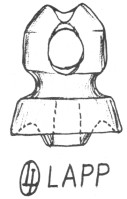
Dear Jack:
I have a Lapp insulator,
about as I have sketched -- 3" wide by 4-1/8" tall. The hole through the
crown is about 1", and it has a 1/2" pin hole. Any info?
Ted Lovett
Vernal, Utah
- - - - - - - - - -
Dear Ted:
We ran this same item in the Dec 1973 column (page 17),
plus this one and a similar one made by Findlay in the Oct 1972 column (page
26). Guess it's time for a LAPP repeat answer on it.
This is a form of a
"wireholder" insulator. Ordinary wireholders used to terminate low
voltage power wiring on houses are very common, but these styles with a flared
skirt and interior petticoat are evidently very uncommon. They also are found
with cemented-in clamping mounts for use on pipes. The skirted design was
probably intended for high voltage applications such as supporting the drop
wires to series street lamps and such.
Jack
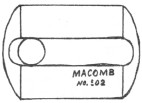
Dear Jack:
I recently came up
with several new items I have questions about.
First is a strain with embossed
(raised letters) MACOMB, and a "NO. 602" I think. It looks to be a dry
process, and it has an unglazed firing rest on one end. What info can you give
me on it? Value?
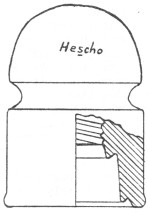
Next is a white beehive about like I've sketched. Looks about
like pictures I've seen of the GISBORNE PATTERN beehives. This is a whiter glaze
than any porcelain I have ever seen, and it makes my Locke Hi-Tops in white look
dull by comparison.
The dome has a "Hescho" marking, and I was told it
came from Canada. What can you tell me about this one?
As a third question, I
would like to know anything you can tell me about threadless porcelain. How many
styles are there? What do they usually sell for, and where can I get one? I am
especially interested in the threadless egg that Ray Klingensmith wrote up in
the February issue of Crown Jewels.
Brent Burger
Kirkland, Wash.
- - - - - - - - - - -
Dear Brent:
Your MACOMB strain is a dry press item made by Illinois Electric Porcelain, most
probably in the 1911-1920 period. When they started also making wet process
insulators in 1915, they commenced use of the Triangle-M marking on those items,
and eventually the surviving dry press items carried the Triangle-M marking as
newer dies were made.
Although not rare, your MACOMB strain is a good collector
item, since a number of collectors do specialize in Illinois insulators. These
early poleline insulators (strains & pin types) and various "standard
porcelain" and specialty insulators with the MACOMB embossing are
especially fun to collect. Incidentally, the partly legible number in the
marking should be "No. 502" instead of 602.
I can't tell you anything
about your "Hescho" pin type other than that our Canadian readers say
they have been used by Canadian utilities and that they were allegedly
manufactured in Japan. [See letters on the preceding pages.]
We currently have
ten different porcelain threadless in the Universal Style Chart, and seven of
those are in the very rare to exceedingly rare category (either unique or
several known). Of the lot, about the only ones generally available for sale at
shows or from dealer stocks are the U-980, U-981 and U-988. The more common ones
are in the $200 range at best, and the very rare ones could go for $500 to $1000
if and when one is ever put up for sale. As with any rare items, you just have
to beat the bushes -- go to large shows, read the CJ classified ads, write to
dealers. It's helpful if you also have a fat piggy bank for these.
Jack
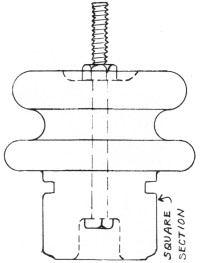
Dear Jack:
I am sending you several different examples of insulators I picked up
near an old railroad track southwest of Denver about 5 years ago. I have not
been able to identify them or determine their use. I sent samples to Gerald
Brown, and he didn't have any idea on them either.
These were in an area where
railroad cars were dismantled. The insulators could possibly have been used in
telegraph or railroad signal systems. I have about 25 styles of these. They are
dry process porcelain with either black or brown glazes, and all are of the same
general idea as the samples sent. Variously they have two to four side fins. All
of them have two nuts and a cap washer on the threaded bolt, and various sizes
of wires were attached with these to the top terminal. Some, but not all, have a
wire brazed to the bolt head and coming out the other end of the insulator (the
"bottom" above).
These have a square base section which goes through a
panel about 1/4" thick and are held in place with a snap ring in the little
side notches at the back of the panel. But I have one which has little lugs on
the base part so it can be placed in the panel hole and turned to lock it in
place.
Any ideas on them?
Roy Curran
Denver, Colo.
- - - - - - - - - -
Dear Roy:
I held a couple of
these behind my new crystal ball, but that didn't even help much. The only thing
I could see were some outlines of a couple of collectors who did know the
answer. The images were too fuzzy to identify the fellows, so we'll just have to
wait until one of them writes us with the answer -- as surely he will.
Jack
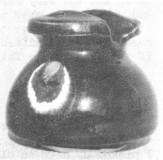
Richard A. Peterson (Oakland, Calif.) sent more of his very nice photos of some
unusual items in his collection, plus a few shots by telephoto of some goodies
still in use in his area. I've selected just several of these super photos to
show you how nice they are.
Richard collects any insulator that shows scars from
flashover, but he doubts that many collectors similarly value these items. The
photo at right is just one sample of the interesting "victims".
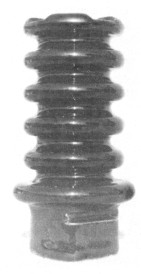
Pictured at left is a porcelain bushing with markings of Star Porcelain Co.,
Trenton, N.J. That may come as a surprise to some of you.
Richard also sent
photos of a Locke TJ-670 which has the prominent "VICTOR" handstamp on
the skirt -- but also the same marking around on the other side of the skirt. He
wonders "if it was done on purpose to end a customer's complaint that the
buyer couldn't find the name on the insulators."
This double VICTOR marking
is not normal, but it's not unreasonable to have occurred. These incuse marking
stamps naturally didn't even require an ink pad, and a worker can stamp a whole
tray of "green" insulators before you can blink an eye. It would not
be unusual to miss some of them or to hit some of them more than once at the
speed it's done. Insulators are items of utility, not pieces of Dresden China
artwork. Little care is taken in applying these or other identifying markings to
ordinary pin types and other forms of high production insulators.
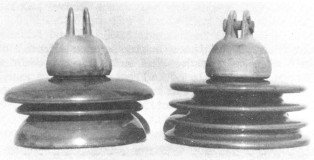
Pictured above are two fog-type/clevis-type suspension insulators made by Lapp.
The one on the left (1964) is a later version of the older one (1947) shown at
the right. That's quite a radical change in design.
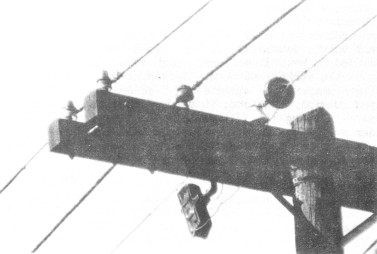
This telephoto shot should
probably win a prize for the best duke's mixture of collectibles on the end of
one simple crossarm -- two glass CD-162, porcelain U-625, white U-418A fog bell,
6" Hewlett disk, and a porcelain fuse cutout.
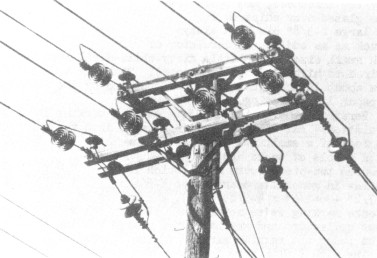
Deadending a couple of
3-Phase lines in the Oakland area. You may be distracted by all the 10"
Ohio Brass disks, but don't miss noting all those old Locke #408A pin types on
the crossarms to secure the jumper wires. Less obvious are the old angle-iron
crossarm braces, the metal gains brackets, the metal rods connecting the
suspension disks to the crossarms, the porcelain "HIGH VOLTAGE" sign,
and the charred top crossarm.
There's one tower on the main northbound 735 kv
line out of Phoenix which has a lot of porcelain for a single tower in an
ordinary straight run, and I stare at it every time I travel to the mountains.
It has two 3-phase lines, both deadended in both directions. Each conductor is
deadended with double strings of about 30 suspensions each, and each of the 6
jumpers are steadied by V'ed suspension strings. If you multiply that out, it
means 1080 disks on this one tower -- meaning a total insulator cost of over
$20,000. No wonder we can't afford the electric bill nowadays.
Many thanks to
Richard for sending some of his excellent photos so all of us could enjoy seeing
them.
Jack
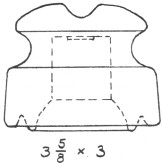
Dear Jack:
We bought this insulator for $.50 at a bottle show in
upstate New York over 9 years ago, and I'm ashamed to admit I never brought it
to your attention before this. It's a dirty-white glaze and is rather crude and
misshapen. For example, the outer skirt varies from 5/6" to 7/16"
thickness, and there are some glazed-over chips on it. The large 1-3/8" pin
hole always struck me as odd for an insulator of such small size. The little
dirty-white-devil must have aspired to higher things (voltages)! There is a
definite aura about it that just cannot be conveyed by the sketches on paper I'm
enclosing.
Here's another Pittsburg date control marking for your tabulation:
MAY 25 Ans'd. It's stamped into the unglazed top rest of a small two-piece multi
something like U-958.
A couple of weeks ago, we picked up a cemented two-piece
Locke multi which is similar In general appearance to U-866
(4-7/8" - 6-1/4" x 4-7/8" tall), and it has a Locke marking we've
never seen before.
U.S.A. PAT.
? - 22 - 20
But we're primarily glass collectors and may have just missed
knowing about it. Right under the regular marking of the transmission insulator
outline with VICTOR word is this added marking with a patent date. I cannot make
out the one-digit month in it.
For a couple who is primarily into glass
insulators, we've been picking up mostly porcelain of late. We just couldn't
pass up a mint U-925 in sort of an olive-mustard color for a fiver at a show
recently, however!
Karen & Jarl M. Anderson
East Freetown, Mass.
- - - - - - - - - -
Dear
Karen & Jarl:
Manufacturers used numerous markings on all forms of
insulators other than unipart pin types (strains, suspensions, multipart pin
types, bushings, etc.), and we've generally ignored them. Re your marking on the
Locke multi, the only month in 1922 with Tuesday on 22nd day is June (6-22-20).
I have listed in my old patent search tabulation sheets the following one:
6-22-20, Reissue #14,888, Volume 275, page 770 ----- (multipart).
I recorded info on
over 800 patents of potential collector interest, but didn't record card-file
info on many hundreds of patents on multis, suspensions, etc. If you get near
the Gazettes in a library, you can look up the above one and see if it fits your
insulator.
The small, crude item with the top groove and 1-3/8" pin hole is
really unusual. Wonder who made it and also what it was used for. I saw in 1971
or 1972 at a New York show a small item with 1-3/8" hole which I recall as
something like the U-29 pony. Believe me, that was a real oddity also! It was
barely big enough to surround the tip of a 1-3/8" pin.
Needless to say, I
continue to be intrigued with your name, Jarl, all in that one of the
manufacturers that figures prominently in our collectible insulator specimens
was "Albert & J. M. Anderson Mfg. Co." of Boston, Mass.
Jack
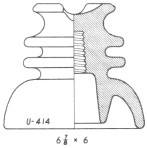
Dear
Jack:
I managed to find some of the U-414's (see CJ, Dec '79, page 30). They are
all brown glaze with the Victor Insulators Inc. marking of a rectangle-V. They
have a black top portion and also a black pin hole, and I assume this is the so-called
Radio Treatment.
I found out from a lineman who has changed out many of these
one of the reasons there are not too many of these around. It seems that at the
voltage these were designed for they break down (puncture) from the saddle
groove top to the pinhole.
Tom Kasner
Casper, Wyoming
- - - - - - - - - -
Dear Tom:
Yes, the
black area on the insulator crown and the black glaze in the pin hole are the
"radio treatment". An oversimplified explanation is that, without the
addition of this semiconductive glaze, the line conductor and tie wire which are
at a very high potential with respect to ground come into contact with only a
tiny area of the insulator's surface. The result is a highly stressed electrical
point at these contacts, not to mention the ionization of the air at all the
points where the wires are not in good contact with the porcelain. The
semiconductive glaze merely forces the high line voltage to occur evenly over a
large area of the insulator, thereby eliminating the hissing and spitting
problems.
Similarly, the conductive glaze in the pin hole shorts that whole
large area of porcelain surface to the grounded pin, eliminating any voltage
stress of the little air gaps between the pin and insulator and a profusion of
small physical contacts between the metal pin and the porcelain.
What the
lineman told you must be correct, since years ago engineers at P.P. Inc. (who
also made this design) said the thing was a real dud of a design for lightning.
From what you say, I presume he meant that they just punctured through the crown
instead of flashing over. That's a no-no.
Jack
| 